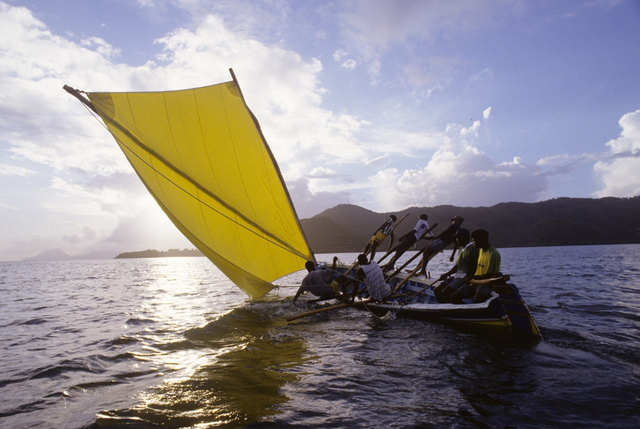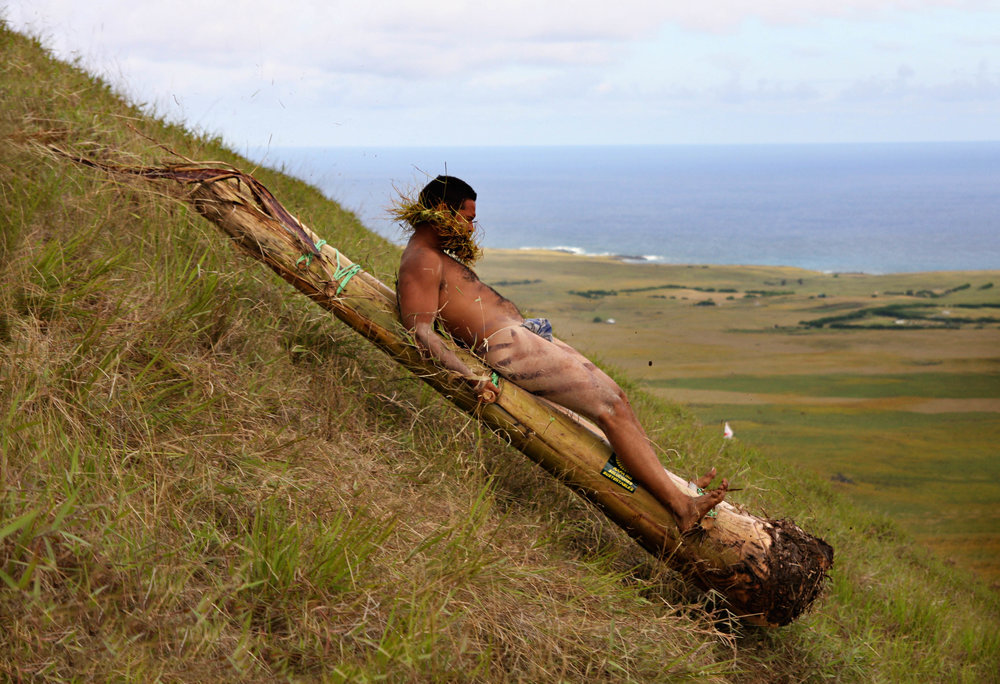- Name of sport (game): Capoeira
- Place of practice (continent, state, nation):
Brazil
- History:
Caption, jogar capoera ou danse de la guerre (capoeira play or war dance); men and women onlookers; drummer on right. Capoeira is a Brazilian martial arts-dance form whose origins are obscure: it may have originated in Africa or in the slave quarters of Brazilian plantations. In any case, it is a uniquely Brazilian practice, and the term can signify an individual who engages in the athletic pastime of the same name, in which the participant armed with a razor or a knife, with rapid and characteristic gestures goes through the motion of criminal acts (translators note in Gilberto Freyre, The Masters and the Slaves [New York, 1956], p. 48, note 120). A more recent view and detailed analysis stresses The capoeiras organized public contests for entertainment. They played capoeira in military and religious processions and scorned and derided public officials. Their performance was accompanied by music, dance, and interaction with the spectators. Although public officials attempted to brand the capoeiras as dangerous and violent hoodlums,the masses admired and respected the performers (Maya Talmon-Chvaicer, The Criminalization of Capoeira in Nineteenth-Century Brazil, Hispanic American Historical Review, vol. 8 (2002), p. 525).
Source: http://www.slaveryimages.org/s/slaveryimages/item/1020Capoeira is a martial art that developed from combat games enslaved Africans brought to Brazil. It is systematically documented since the beginning of the 19th century in Rio de Janeiro and later in other port cities. During the 19th century capoeira was increasingly practiced by the poor free people, black and of mixed ancestry, and also by white immigrants. Capoeira gangs controlled their territories against intruders and allied with political parties until the Republican purge of 1890. Capoeira survived best in Bahia, where it remained more associated with other forms of Afro-Brazilian culture and acquired many of its features still extant in present-day capoeira. From the 1930s onward, capoeira masters such as Bimba and Pastinha modernized capoeira, leading to the emergence of the Regional and Angola styles. Bahian capoeiristas migrated to Rio de Janeiro and São Paulo in search of better opportunities during the 1950–1970s. There they and their students developed what later became known as “Contemporary capoeira” (Capoeira Contemporânea) which is the most practiced style today. Capoeira was and is practiced in various ways: as a friendly game or as a fight, as a combat sport, or as an Afro-Brazilian cultural activity. Since the 1980s, capoeira has undergone a process of globalization and is now practiced in many countries around the world. Capoeira is the only martial art of the African Diaspora that is known and practiced worldwide.
Source: https://oxfordre.com/latinamericanhistory/view/10.1093/acrefore/9780199366439.001.0001/acrefore-9780199366439-e-293?printPlaying Capoeira or Danse de la Guerre, by Johann Moritz Rugendas, 1835
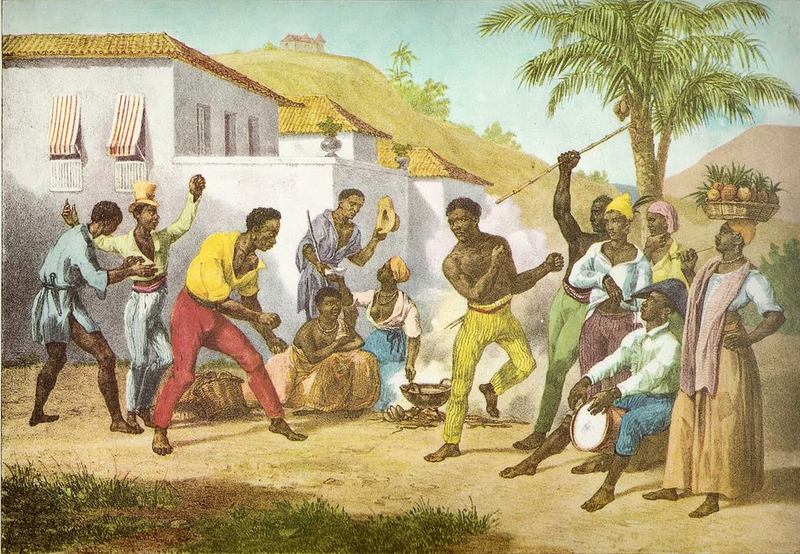
- Name of sport (game): Carrera vosá
- Name in native language: Carrera vosá
- Place of practice (continent, state, nation):
Paraguay
- Name of sport (game): Esgrima criolla
- Place of practice (continent, state, nation):
Argentina
- Name of sport (game): Gommier
- Name in native language: Gommier
- Place of practice (continent, state, nation):
Martinique, Dominica, Santa Lucia
- History:
Gommier is a traditional Indian boat from the Caribbean, which at first neither had sail nor rudder. It was used for fishing and transport. Without a doubt, this is the oldest type of boat in Martinique.
Gommier is a traditional boat, today built by using the same techniques as in the past. There were such boats used by locals to fish and move between islands, even before Christopher Columbus reached West Indies.
Boat’s construction technique is connected with the presence of Native Americans who once inhabited Western India. Gommier had been the main transport for the Caribbean people since population appeared in this region of the world, until the arrival of settlers in the 16th century.
Gommier is used all over the Martinique coast. During the Second World War (1939–1945), young residents, responding to General de Gaulle’s command on June 18, 1940, joined the free French armed forces in Saint Lucia and Dominica, using this type of boat. This period of Martinique's history is known as "la dissidence" (resistance). During this period, the ban on cutting trees contributed to the prevalence of the gommier-like boat called Yole. The shortage of trees made them gradually replaced by motor boats.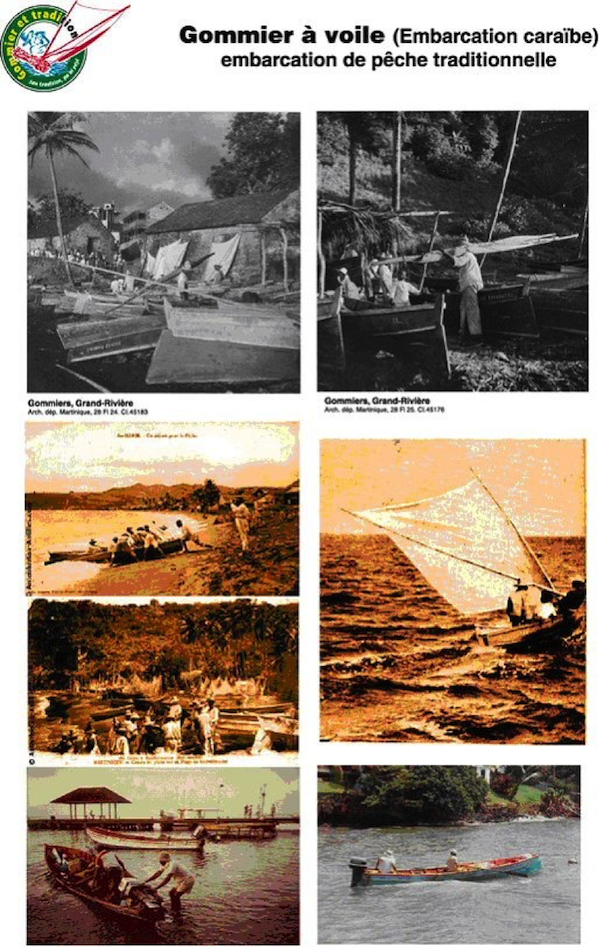
- Description:
Gommier is a one-piece ship made of trunk ("bwa fouyé") and is named after this tree.
Both boats (Gommier and Yole) do not have a keel, that is why there is the need to use "bois dressés" as a counterweight. Gommier is considered to be more unstable and therefore it requires more work from crew members. With unqualified crew, overturns are frequent. The Gommier boat usually measures 5-7 meters.Yole is built from a frame on which boards are installed. The boat is guided by long paddles placed on the back of the boat. During competitions, Yole crews consist of 15 crew members and have sails up to 80 m2. The Gommier crew consists of 10 people and their sails have from 55 to 60 m2.
Technical differences do not make Yole boats better than Gommiers because in sailing, with the exception of crew competences, motivation and experience, as well as work organization; the quality of the material and the weight-power ratio of the boat are essential. It is not always enough to have the biggest sail in order to win.
Gommier is a very demanding team sport in which the crew must show endurance, flexibility, discipline and technical skills.
Anthropologist Thierry Letang has analyzed the materials from which boats were made in the Caribbean. According to him, Taino-Arawak of the Great Antilles or Kalinago of the Lesser Antilles built their boats called kanawa or kanaoa, using different materials:
1. Cedrela Odorata, local mahogany, red mahogany, mahogany cedar, red cedar, large combat pirogues.
2. Dacryodes excelsa, Gommier blanc tree (white), was used to build large boats, although the size of the trunk is generally smaller than the red mahogany. Its resin or rubber was also used to seal gaps.
3. Bursera simaruba, called Gommier rouge (red). In the end of 1690, Labat claimed that, contrary to what other researchers have said (i.e. Du Tertre), this material is not useless and many used it to build the boat.
4. In the Great Antilles for the production of pirogues Ceiba pentandra was used, which could accommodate up to 150 rowers. On the continent as well, it is possible that residents could do the same. We have the knowledge that they have made small offshore fishing boats and "cassava boats" intended for transporting sand or flour. The canoes had to be dry to avoid rotting the wood, which was called "flo" (light).
5. In the Great Antilles was also used Figuier maudit, called "bwa flo" (Ficus indica or citrifolia); as well as Ochroma pyramidale called fwomajé, pripri, mapou, bwa flo, balsa.
6. For boat production Taino people could also use mahogany (Swietenia mahogani) or galba (Calophyllum calaba).
7. Guillaume Coppier, as one of the few sailor writers, mentioned Hymenea courbaril, which was used for the production of boats in the Lesser Antilles.
8. Elements of the boat called chimalouba in the Caribbean (which are also found on the Gommier, except the fact that they are fastened with nails) were made with white mahogany (Simarouba amara) and their sides were covered with Ischnosiphon arouma.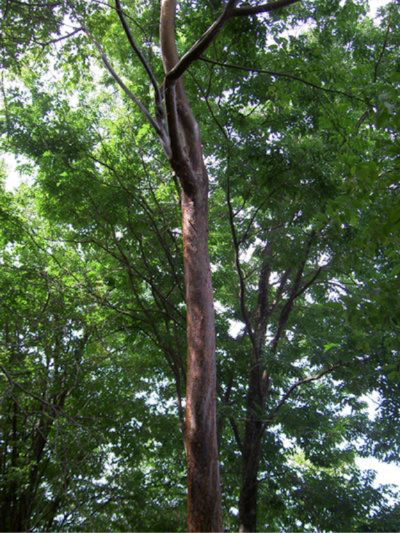
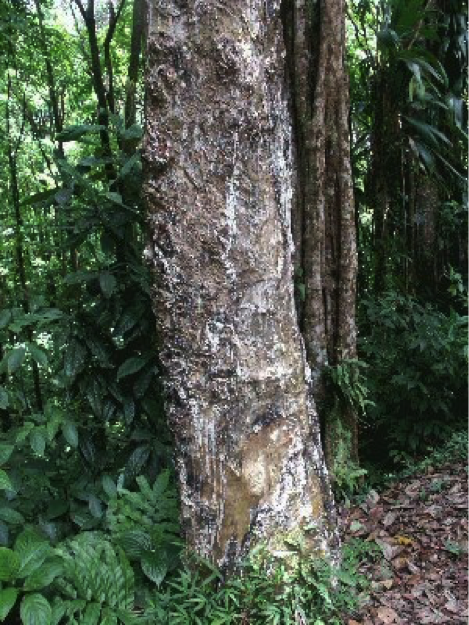 Bursera simaruba - Burseraceæ - Gonmyé, gonmyè wouj, gonmyé bayè.
Bursera simaruba - Burseraceæ - Gonmyé, gonmyè wouj, gonmyé bayè."I visited our forests and soon found a tree sufficient to be used to build a boat: thirty-eight feet long, five feet wide in the center – it was Gommier.
That tree is called a Gommier because it self-ejects, or when an incision is made, a significant amount of white rubber – fragile when well dried, usually waxy, with an aroma that burns perfectly, regardless whether it burns directly or with a candlewick. The smell of it is pleasant. Nothing better cleanses the air, or a place that has been closed for a long time, than burning this rubber. The inconvenience is the fact that its smoke is thick and very dark. That is the reason why few people make candles…
We realize how big these trees are when seeing the size of the boat. They are even bigger than the ones I used. I found one of them much later. It was about eighty feet in trunk, round, as if it has been rounded, and straight as an arrow…
The point is that Gommiers, until I was in Les Isles, were used only to build a boat. Residents did not even use it for the fire, claiming that it was difficult to cut them into pieces, and that it made a dark flame out of the fire. I was the first who appreciated Gommiers’ importance and found ways to use them for different purposes."
Jean-Baptiste Labat, 1742. Nouveau Voyage aux Isles Françoises d'Amérique, Paris. (Rééd. 1972, Fort-de-France, éd. des Horizons caraïbes).There are two varieties of a rubber tree, or "dacryode hexandra", according to its botanical classification, differing only in tree bark: one is red and the other one is white. The white species have almost shiny and smooth bark, while the bark of red species is wrinkled and cracked. The trunk can be very thick and tall despite its irregular shape. Composition of the wood is very dense and durable. It also has a waterproof and very aromatic resin (with incense fragrance). The ships, of course, received the name of the tree from which they were created.
The red cedar - Cedrela odorata - seems to be the first wood used for Gommier production. There are examples of cedar ships that look like Arabian boats. Cedar is a tree larger than a rubber tree, therefore it allowed the builder to produce larger boats carrying more passengers or goods, however due to their size it was poorly maneuverable. Besides these two types of trees, the inhabitants of the Caribbean used other varieties of trees to build not only the hull, but also ship equipment.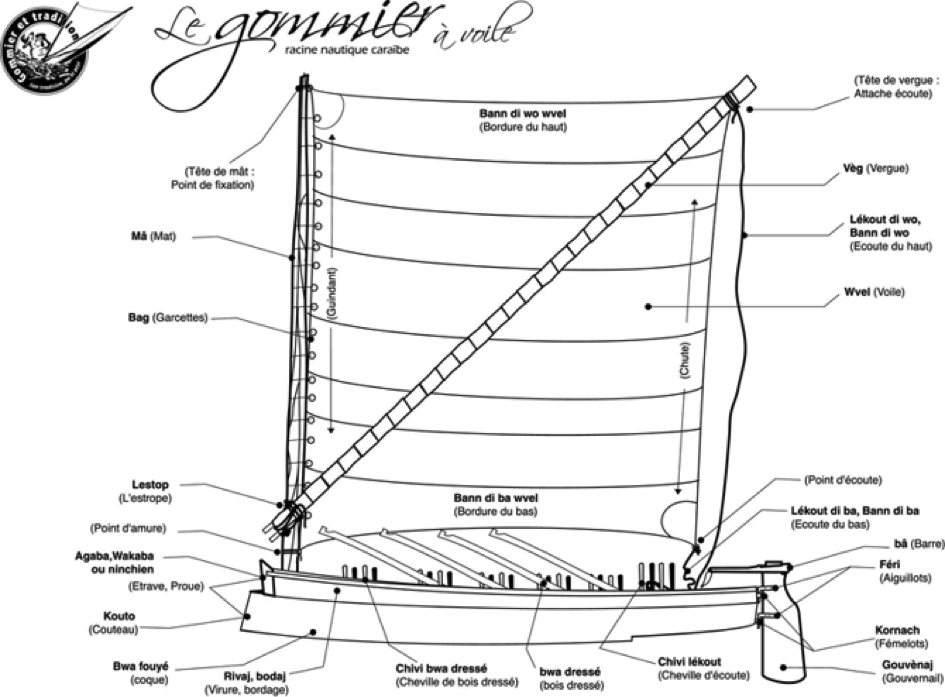 Source: http://gommier-tradition.blogspot.com/p/lavwa-ka-ba-n000_02.html
Source: http://gommier-tradition.blogspot.com/p/lavwa-ka-ba-n000_02.html
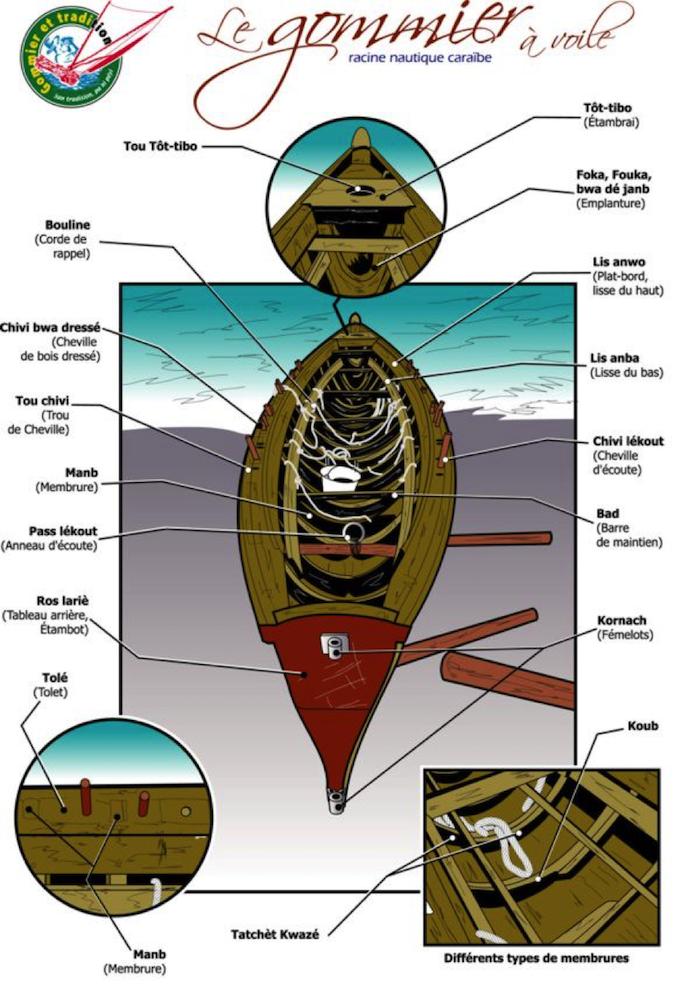
The Gommier boat construction process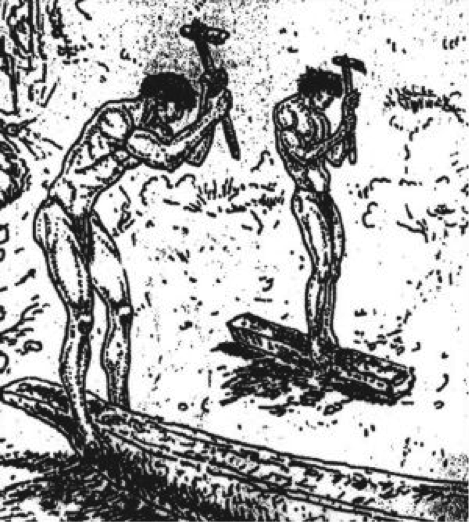
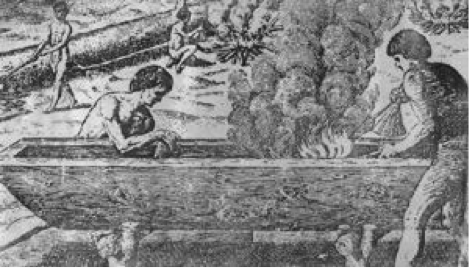
The tree cut was traditionally carried out during the new moon, because a tree that is cut some other time quickly breaks down and is easily attacked by pests. The place where the tree fell was thoroughly cleaned, and the branches were removed so they would not damage the trunk. In this way, the trajectory of the fall of the tree was controlled, which allowed to avoid endangering human life and damaging the material. Loaders attached to the tree and ropes attached to the branches helped to direct the fallen tree, as well as slowed down the fall.
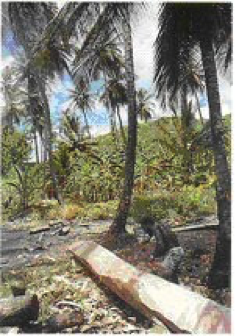
When the tree was already on the ground, it was peeled, then the unevenness was smoothed to give it its proper shape. On both sides of the tree the part was cut to a certain length. Afterwards, it was tightly bind by lianas.
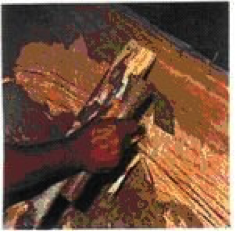
If the branch was slightly flat on one side, the hole was cut in there. If not, one side had to be slightly flattened. By using an ax (now saw) a recess was formed in the middle, then the middle was burned out (around the hole wet mats were put, so that the burn would not spread to the whole boat).
In order for the tree to retain its properties, it was necessary to protect it from intense sunrays, as well as from the influence of the earth (eg. moisture). That is why they were placed on beams about five-six inches above the ground, while dowels were put in the center.
At each ends and sides pins are dug into the ground to support and stabilize the hull. This position is perfect to hew the hull – very gently so it would not damage the whole structure. The bottom have to be flattened from the inside, so it is usually thicker than the sides. Similarly, the front and back are slightly thicker than the center. The front is slightly tapered, and the back is taller and diagonally cut in order to place the hinges, on which the rudder should be placed. The stability of the boat mostly depends on the precision of the hewing, on the accuracy and proportion. Too thick walls will slow down the boat, too thin will cause the overturn.
Afterwards, the boat is turned, smoothed and polished. During the work the boat should be in the shade and immediately after it is ready it should be launched.This construction process allows to create a boat about 7 meters long and about 50 centimeters wide. But the builders tried to expand these boats to make them more comfortable and more spacious. Two methods were used to widen the internal part. One of them was to fill the interior with stones and sand, then with sea water. Over the following days, the edges widened, which was caused by the weight of the material and the rays of the sun. It took about 30 days to achieve the desired effect. The second way is a lot faster (it is used especially on Santa Lucia): it is to fill the interior with water. After a few days of soaking, small branches, sawdust and dried banana leaves are burned inside. The heat expands the sides of the boat. This method takes one day. In both cases, the builder must control the process so that the sides expand evenly and are parallel to each other. These techniques are almost doubling the interior of the boat. Regardless of the chosen method, knowledge of wood, control over heating, it is important to watch this process very carefully, because the bursting of wood destroys the whole boat.
However, the process of expanding the boat is usually successful. Then the finishing works begin, which do not have to be performed by the same people. Currently, the hulls made on Santa Lucia are finished in Martinique, because they are used by its inhabitants. The hollowed hull forms the bottom of the boat and can reach from 7 to 9 meters, although it usually ranges from 5.2 to 7.2 meters, the width after the extension is about 90 centimeters, and the depth is about 40 centimeters. The center is slightly lowered towards the front, which is the effect of expansion. The front is therefore taller, ended with a spur with a triangular profile on Dominica and rectangular on Santa Lucia.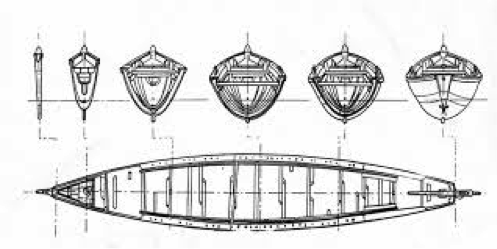
The sides gently lead to the stern. The keel is marked by light ribbing.
Inside the hollowed hull, five or six ribs are fastened to maintain the shape of the boat. On the outside a wooden belt is installed, going along the hull (wider in the middle part), often made of different wood.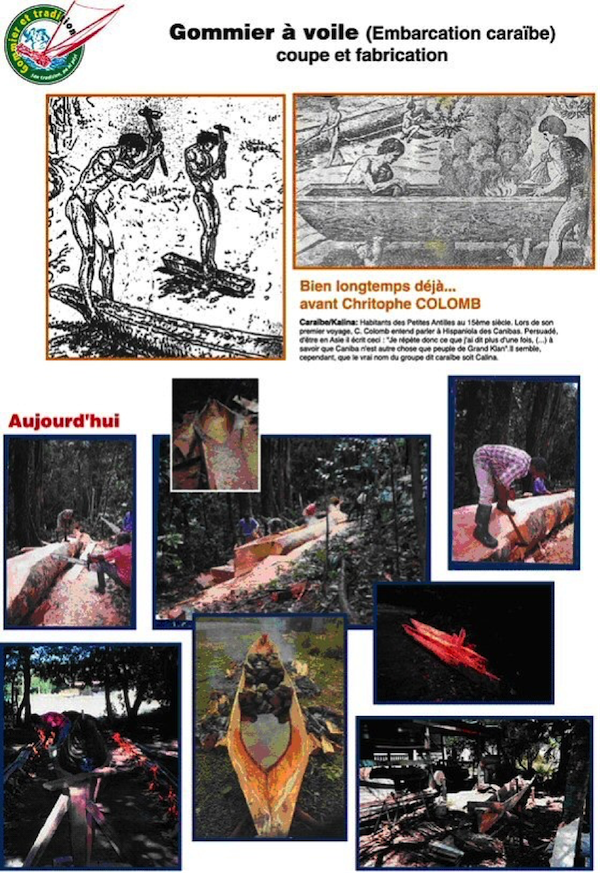
- Current status:
Nowadays, many associations contribute to the popularization of this traditional sport. About 18 regattas are organized every year. The most important regattas often have thousands of viewers (75,000 people in Schoelcher during the Yole regatta in 2004), and the whole island is focused on this event. In August the most important event in the race calendar takes place: Tour of Martinique.
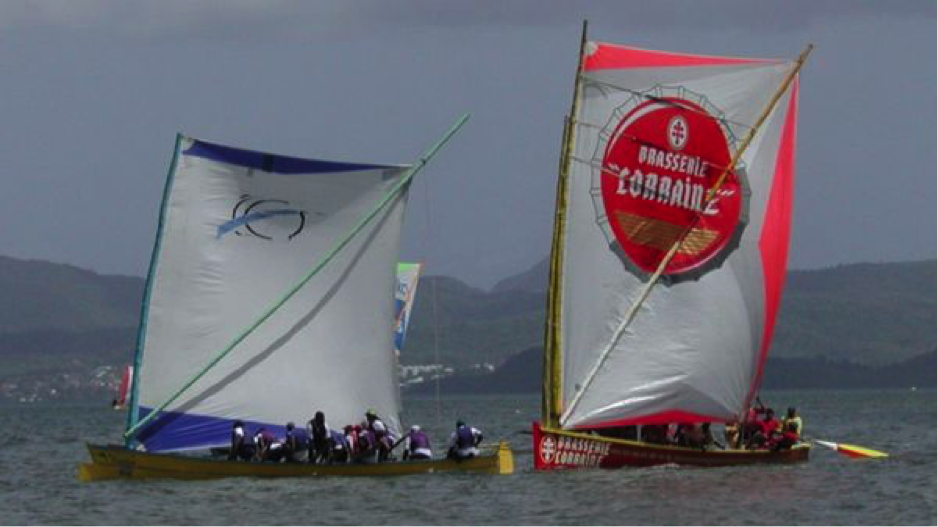
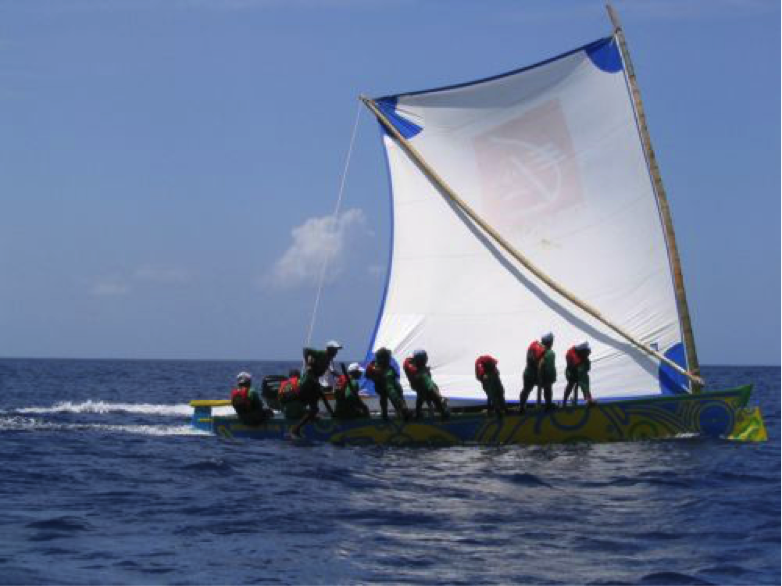
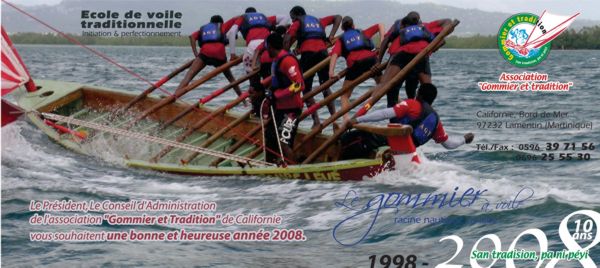
- Contacts:
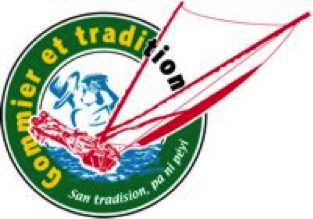
Association Gommier et Tradition, Bord de mer, Quartier Californie, 97232 Lamentin (Martinique).
Tel/Fax 0596 39 71 56 - 0696 25 55 30This email address is being protected from spambots. You need JavaScript enabled to view it.
http://gommier-tradition.com
http://www.campuscreole.com/gommier-et-tradition.htm - Sources of information :
https://fr.wikipedia.org/wiki/Gommier_(bateau)
A. Guillou, A. Lagin, Engins et techniques de pêche de la Martinique, http://archimer.ifremer.fr/doc/1997/rapport-1120.pdf
G. Blanchet, B. Gobert, J.-A. Guérédrat, La pêche aux Antilles, Institut de recherche pour le développement, Paris 2002Video:
https://www.youtube.com/watch?v=MW55gq1MWCASource of photos used in this article and gallery:
https://forum.game-labs.net/topic/23520-le-gommier-a-traditional-caribbean-fishing-boat-with-plans/
https://en.calameo.com/books/0063746760e4b858e2a4b
https://www.researchgate.net/figure/Plan-dun-gommier-document-association-Alizes-Martinique_fig3_273777158
https://www.potomitan.info/divers/gommier1.php
https://www.potomitan.info/divers/gommier2.php
http://www.assemblee-martinique.com/nuke/html/modules.php?name=News&file=article&sid=240
https://www.martinique.franceantilles.fr/actualite/sports/le-championnat-des-gommiers-est-lance-ce-dimanche-509368.php
https://www.martinique.franceantilles.fr/actualite/culture/un-jour-un-patrimoine-le-gommier-536734.php
http://www.campuscreole.com/gommier/?i=1
http://gommier-tradition.blogspot.com/p/lavwa-ka-ba-n000_02.html - Gallery:
- Name of sport (game): Haka Pei
- Name in native language: Haka Pei
- Place of practice (continent, state, nation):
Easter Island
- History:
A cultural tradition that developed on the island long ago occurred when a youth wanted to prove to his clan that he was no longer an adolescent and should be considered an adult and a warrior. That tradition was the famous "Haka Pei" test.
This involved hurtling down the side of a volcano riding on a banana-trunk sled. The volcano used for this test of speed and nerves was either Maunga Tangaroa or Manga Otuhu. The Pascuans (Easter Islanders) very knowledgeable about their culture note that this test began on the slopes of the sacred volcano, Rano Raraku, and the mountain Pu Makari.
At the same time, the Pascuans had another version of "Haka Pei". This version believes that the haka pei was part of the training of warriors in order to become brave to fight the other clans of the island. This was called "Ma’ari". Future warriors were supposed to slide as fast as possible along a cord several kilometers long that connected a volcano summit with a sacred rising point in the valley. Old timers say this harrowing test was conducted between two volcanoes - Pu Makari and Maunga To’uto’o, or between the summit of Pu Makari and the Tongariki platform. - Description:
Competitors choose banana trunks making them strong and thick to support the competitor's weight and friction with the grass. Then they transport them to the base of the hill and leave them for a few days so that the trunks absorb the energy of the place. Before the test, the trunks are mounted at the top of the hill with the help of a pulley, are cut with a machete then are tied with ropes and stakes. The day before, the competitors participating for the first time go to the Church of Santa Cruz to pray. Before the start, the competitors stand in a circle and pray maké maké (deity of Easter Island) to obtain the mana (spiritual power) which protects them, an umu tahu (local curanto) honors the ancestors who practiced haka pei and blessed the current competitors.
The "Haka Pei" event has place on the 35-degree slopes of the volcano Maunga Pu’i. Competitors must descend the hill on two banana trunks linked together, the goal being to get as far as possible by being the fastest. The hill measures 120 meters and is inclined at 45 °, the descent is about 300 meters and the competitors can reach 80 km / h. They are dressed in a hami (loincloth) and takona (traditional painting using ki'ea, natural pigment). During the event, spectators eat an umu tahu.
All along the 600-meter (1,969-foot) course down the volcano slope, there is a judge every 100-meters (328 feet) using a stopwatch to help accurately calculate the speed of each contestant. The winner is not the one who reaches the fastest speed, but the one who makes the descent in the fastest time.
Some practice the haka pei tandem which consists of going down two on the trunks, which doubles the weight and increases the speed.
The haka pei is a dangerous sport, only about twenty rapa nui take the risk of participating in it. There are regular accidents.
According to tradition, the gods always demand sacrifices before a Haka Pei test is held. So two white chickens cover the "cost" of the Umu Tahu tradition. Such sacrifices are still routinely practiced for all-important activities that highlight the contemporary lives of today’s Pascuans.
Once the Haka Pei test ends for another year, the gods must be thanked for those left to live. So an "Umu Hatu" is organized, offering the gods food, such as sweet potatoes and yams. - Current status:
Today, the haka pei takes place on Maunga Pu'i hill during the Tapati Festival. As a result of many accidents, the ancient test of manhood was forbidden for two years, from 1990-1991.
Today, participants of Haka Pei riske their lives and bones on the slopes of the Maunga Pu’i volcano to maintain the tradition, but also to win a cash prize of around 770 USD. - Importance (for practitioners, communities etc.):
The "Haka Pei" was revived from a cultural graveyard in 1981 by a handful of culturally motivated islanders, including two Pascuans—Maea Puhi and Hucke Atan.
The "Haka Pei" takes place during the Tapati Rapa Nui Festival, the traditional celebration held each year during the first two weeks of February. - Sources of information :
Place of Haka Pei competitions - https://www.360cities.net/image/111-easter-island-haka-pei
Articles:
https://imaginaisladepascua.com/haka-pei/
https://prezi.com/0i8mo3qsjscz/haka-pei/Video:
https://www.youtube.com/watch?v=h5-qQybEc14
https://www.youtube.com/watch?v=CuMS_xZHzIgSource of photos in this article:
https://imaginaisladepascua.com/en/haka-pei-the-extreme-sport-of-easter-island/; https://odkrywcy-swiata.pl/?p=647; https://galapagostravel.online/tapati-festival; https://tambotravel.com/blog/tapati-festival-easter-island-traditions-and-culture/; https://pt.travel2w.com/3735-the-worlds-strangest-sports; - Gallery:

